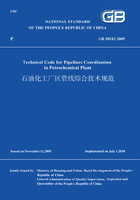
9.2 Control Survey
9.2.1 For control survey,the mapping control points shall be laid out based on the existing hierarchic control network.In case of inadequate density for the hierarchic control points at plant site,the number of hierarchic control points shall be densified according to the current applicable professional standard SH 3100 Specification for the Engineering Survey in Petrochemical Industry.
9.2.2 The pipeline control points shall be measured by GPS(Global Positioning System)technique,and operating model including static,fast static and kinematic survey may be used.The operating method and data processing for GPS survey shall comply with the specifications in the current applicable professional standard CJJ 73 Technical Specification for Urban Surveying Using Global Positioning System.
9.2.3 The dolomite traverse should use the EDM method,whose main technical specifications shall comply with the specifications in Table 7.1.3-2 of this Code.
9.2.4 The number of mapping control points should be densified by analytical polar positioning system.The side length shall be measured by EDM instrument,which shall not exceed 3 times of the average side length specified in Table 7.1.3-2 of this Code by nonreciprocal observation for one observation set.The angle shall be measured in one observation set by DJ6 method of direction observation in rounds,during/after the survey in station,the direction shall return to zero,and the disclosure of round shall not exceed 30″.
9.2.5 For theodolite traverse survey,when EDM method is used for nonreciprocal observation,and when the difference between two readings is less than 10mm,the side length readings shall be taken average.The side length shall be added with the correction for addition constant and multiplication constant of EDM instrument,and inclination shall be corrected by vertical angle,or the horizontal distance shall be directly read on the total station instrument.
9.2.6 When the traverse cannot be annexed subject to the topography limitation,EDM branch traverse with no more than four sides may be set up.For horizontal angle,use DJ6 method of direction observation in rounds to measure the left and right angle for one observation set respectively,and the closing error for closing the horizon shall not exceed±40″.The total length shall not exceed 1/2 of the specification in Table 7.1.3-2 of this Code,and the maximum side length shall not exceed twice of the average side length specified in Table 7.1.3-2 of this Code.The side length shall be measured by reciprocal observation,and the relative error of direct and reversed observing shall not exceed 1/3000.
9.2.7 For calculation of theodolite traverse,approximate adjustment method may be used.The angle shall be rounded to second and the side length and coordinate shall be rounded to“mm”.
9.2.8 The mapping vertical control survey shall begin from the hierarchic elevation point,and traverse shall be laid as annexed/closed leveling line along the pipeline,and shall not exceed two times of annexes.Level with accuracy no less than DS10 shall be used for nonreciprocal observation,and the readings shall be approximately read to“mm”.The leveling error of closure shall not exceed±10![]() mm(n is the number of stations).The calculation for level line may use approximate adjustment method,and the elevation shall be calculated to“mm”.
mm(n is the number of stations).The calculation for level line may use approximate adjustment method,and the elevation shall be calculated to“mm”.
9.2.9 The mapping vertical control survey may use EDM trigonometric leveling method,and shall proceed simultaneously with traverse survey.The height of instrument and tower shall be measured to“mm”.The main technical specification for mapping trigonometric leveling survey shall comply with the specifications in Table 9.2.9-1 and the technical specification for vertical angulation shall comply with the specifications in Table 9.2.9-2.
Table 9.2.9-1 Main technical specifications for the mapping trigonometric leveling survey

Notes:1 n is the number of traverse sides.D is the ranging length of EDM traverse(km).
2 When calculating the comparation error of elevation difference for reciprocal observations,the impact of earth curvature and astronomical refraction shall be considered.
Table 9.2.9-2 Technical requirements for vertical angulation
